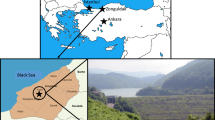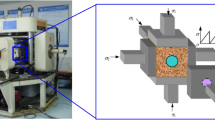Abstract
Copper production is an essential component of the Chilean economy. During the extraction process of copper, large quantities of waste materials (tailings) are produced, which are typically stored in large tailing ponds. Thickened Tailings Disposal (TTD) is an alternative to conventional tailings ponds. In TTD, a considerable amount of water is extracted from the tailings before their deposition. Once a thickened tailings layer is deposited, it loses water and it shrinks, forming a relatively regular structure of tailings blocks with vertical cracks in between, which are then filled up with “fresh” tailings once the new upper layer is deposited. The dynamic response of a representative column of this complex structure made out of tailings blocks with softer material in between was analyzed using a periodic half-space finite element model. The tailings’ behavior was modeled using an elasto-plastic multi-yielding constitutive model, and Chilean earthquake records were used for the seismic analyses. Special attention was given to the liquefaction potential evaluation of TTD.
Similar content being viewed by others
References
Arias A (1970), “A Measure of Earthquake Intensity,” Seismic Design for Nuclear Power Plants, R.J. Hansen, ed., MIT Press, Cambridge, Massachusetts, 438–483.
Aubry D, Hujeux JC, Lassoudière F and Meimon Y (1982), “A Double Memory Model with Multiple Mechanisms for Eyclic Soil Behavior,” In International Symposium on Numerical Models, 3–13.
Bussière B (2007), “Colloquium 2004: Hydrogeotechnical Properties of Hard Rock Tailings from Metal Mines and Emerging Geoenvironmental Disposal Approaches,” Canadian Geotechnical Journal, 44: 1019–1052.
Cifuentes L and Verdugo R (2009), “Undrained Monotonic and Cyclic Response in Thickened Tailings,” In Paste 2009, 313–322.
Hujeux JC (1985), “Une loi de Comportement pour le Chargement Cyclique des Sols,” In Davidovici V, editor. Génie Parasismique, 278–302.
López-Caballero F, Modaressi A and Modaressi H (2007), “Nonlinear Numerical Method for Earthquake Site Response Analysis I–Elastoplastic Cyclic Model and Parameter Identification Strategy,” Bulletin of Earthquake Engineering, 5: 303–323.
Luong M (1980), “Phénomènes Cycliques dans les Sols Pulvérulents,” Revue Française de Géotehnique, 10: 39–53.
Modaressi H and Benzenati I (1994), “Paraxial Approximation for Poroelastic Media,” Soil Dynamics and Earthquake Engineering, 13: 117–129.
Riddell R (1995), “Inelastic Design Spectra Accounting for Soil Conditions,” Earthquake Engineering & Structural Dynamics, 24: 1491–1510.
Robinsky E (1999), Thickened Tailings Disposal in the Mining Industry. E. I. Robinsky Associates, Toronto, Canada.
Sarma SK (1971), Energy Flux of Strong Earthquakes. Tectonophysics, 11: 159–173.
Seed HB, Idriss IM, Makidisi F and Banerjee N (1975), Representation of Irregular Stress Time Histories by Equivalent Uniform Stress Series in Liquefaction Analyses. EERC 75–29. University of California, Berkeley.
Troncoso J and Garcés E (2000), “Ageing Effects in the Shear Modulus of Soils,” Soil Dynamics and Earthquake Engineering, 19: 595–601.
Verdugo R (2009), “Seismic Performance Based-Design of Large Earth and Tailing Dams,” In Performance-Based Design in Earthquake Geotechnical Engineering, Tsukuba, Japan.
Verdugo R (2011), “Seismic Stability Analysis of Large Tailings Dams,” In 5th International Conference on Earthquake Geotechnical Engineering.
Verdugo R and Santos E (2009), “Liquefaction Resistance of Thickened Tailings of Copper Mines,” In 17th International Conference on Soil Mechanics and Geotechnical Engineering.
Zienkiewicz O. Bicanic N and Shen F (1988), “Earthquake Input Definition and the Transmitting Boundary Conditions,” In Advances in Computational Nonlinear Mechanics.
Zienkiewicz O and Shiomi T (1984), “Dynamic Behavior of Saturated Porous Media: the Generalized Biot Formulation and Its Numerical Solution,” International Journal of Numerical and Analytical Methods in Geomechanics, 8: 71–96.
Author information
Authors and Affiliations
Corresponding author
Additional information
Supported by: National Research Center for Integrated Natural Disaster Management, CONICYT/FONDAP/15110017
Rights and permissions
About this article
Cite this article
Ferrer, G., Sáez, E. & Ledezma, C. Numerical modeling of cracking pattern’s influence on the dynamic response of thickened tailings disposals: a periodic approach. Earthq. Eng. Eng. Vib. 17, 179–190 (2018). https://doi.org/10.1007/s11803-018-0433-1
Received:
Accepted:
Published:
Issue Date:
DOI: https://doi.org/10.1007/s11803-018-0433-1




